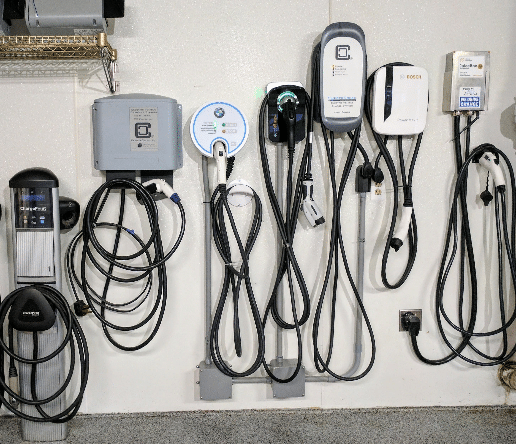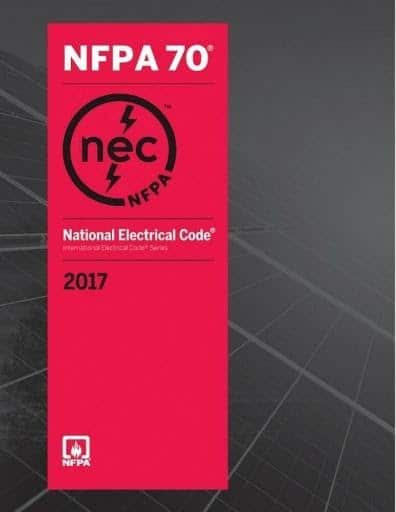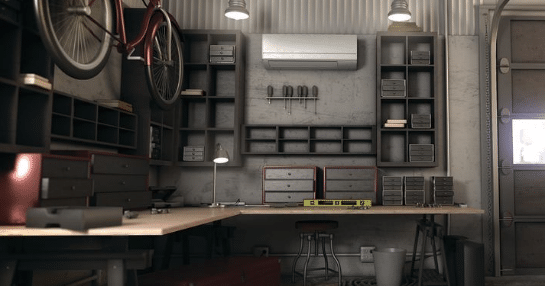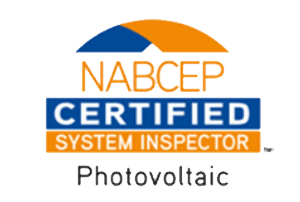Requirements for Fast EV Charging Stations at Home
You decide a level 2 charger is right for you, but your garage or carport does not have adequate existing power supply. You want the EV charging station to be fast, so what conditions must be met to safely install the charging station? Let’s explore some equipment considerations and electrical code requirements.
Not all Charging Stations Are the Same
When considering a new level 2 EV charger some factors must be considered prior to buying:
- Some car chargers require mechanical ventilation when installed indoors. When ventilation is required, two holes must be drilled
 through the structure to provide both exhaust and fresh air make-up. Additionally, a dedicated fan and electrical circuit must be installed. The size of the ventilation holes, and electric fan must be IAW NEC (National Electric Code) tables. This is a function of the EV Charging Station electrical phase and voltage. The mechanical ventilation expels air from the garage or building while bringing in fresh air to ensure any off gassing or fumes generated during EV charging are safely evacuated from indoors. Most charging stations are marked “Ventilation Not Required”, but not all. It is important to check and confirm the car charger is properly tested and marked for indoor operation without ventilation. This step will save considerable money.
through the structure to provide both exhaust and fresh air make-up. Additionally, a dedicated fan and electrical circuit must be installed. The size of the ventilation holes, and electric fan must be IAW NEC (National Electric Code) tables. This is a function of the EV Charging Station electrical phase and voltage. The mechanical ventilation expels air from the garage or building while bringing in fresh air to ensure any off gassing or fumes generated during EV charging are safely evacuated from indoors. Most charging stations are marked “Ventilation Not Required”, but not all. It is important to check and confirm the car charger is properly tested and marked for indoor operation without ventilation. This step will save considerable money. - Current flow creates heat due to resistance in the wire and components. Higher amperes or larger resistance generate more heat and must be factored into both wire and circuit breaker sizing. Larger wire has less resistance to current flow and therefore generate less heat, hence why larger wire can carry higher amperes safely.
- Some large level 2 chargers have a power supply requirement that exceed 60 amperes. Those type of charging stations require a separate readily accessible disconnect in addition to a circuit breaker. The NEC defines readily accessible as “capable of being reached quickly for operation, renewal, or inspections without requiring those to whom ready access is requisite to take actions such as to use tools, to climb over or under, to remove obstacles, or to resort to portable ladders and so forth”. The intent is to provide the homeowner the ability to disconnect power at the point of use in the event of a failure or fire.
National Electric Code and EV Charging Stations

In order to replace an ICE (Internal Combustion Engine), electric motors require large amounts of electricity. The need for electric motors to produce similar torque and power as gasoline engines, coupled with demand for longer ranges necessitates ever larger batteries. Higher capacity batteries require faster charging stations, longer charging times, or both. Because of the higher power output of level two units, each charging station must have its own dedicated electrical branch circuit according to NEC 625.40, (meaning the wire cannot be used for anything else and have no other receptacles, lights, etc).
Even with a fast level 2 charger, the total charge time for vehicle batteries is dependent on numerous factors such as remaining charge in the batteries, total size of the vehicle batteries, chemical makeup of the battery, and the ambient temperature. NEC 625.42 considers EV charging stations as a continuous electrical load based on typical charge times of 2 to 6 hours. Cold batteries take more time to charge than warm batteries, more on that later. A continuous load per NEC 100 is defined as an electric load where the maximum current is expected to continue for 3 hours or more. The longer electric current flows the more heat generated in the wire and components. Per NEC 625.41 and 42 this is a critical consideration and must be accounted for in both wire sizing and circuit breaker selection. The wire and circuit breaker must be sized based on 1.25 times the rated load of the car charger.
In accordance with NEC 625.54, all EV charging stations rated 150-volts to ground or less, and 50 amperes or less are required to be GFCI (Ground-Fault Circuit Interrupter) protected. The intent is to protect people from possible electric shock or electrocution in the event of a ground fault inside the EV charging station or in the wiring and components suppling power to the charging station.
Many residential garages or indoor spaces have hose bibs or water faucets available for vehicle washing or to facilitate cleaning. According to NEC 625.56, if the EV charging station is installed in a wet location, the receptacle enclosure must be rated weatherproof with the attachment plug cap inserted or removed. NEC 100 defines a wet location as “installations underground or in concrete slabs or masonry in direct contact with the earth; in locations subject to saturation with water or other liquids, such as vehicle washing areas; and in unprotected locations exposed to weather”.
Whole Home Electrical Surge Protection and EV Charging
In the event of an electrical surge, excessive voltage or current will cause permanent damage to delicate electronics. Nearly all modern appliances, including electric car charging stations, have printed circuit boards which are ultra-sensitive to electrical surges. Electrical surges are caused by utility switching at sub-stations and more commonly lighting strokes. A surge protection device senses voltage and ampere surges, directing them through the electrical grounding system eventually to the earth. A whole home surge protector provides significantly more protection than standard wall plug-in devices and can protect all electrical fixtures in the home as well a charging station. Locations with a high density of lightning strikes are good candidates for surge protection. NLDN (National Lightning Detection Network) found the Kansas City region has one of the highest counts of lightning in the United States. The key is having a quality surge protector properly installed and with a high surge current rating. Most plug-in style surge devices are rated at a scant 5kA rating where whole home surge protectors range from 60 to 100kA.
Space Conditioning to Optimize Charging Speed
Space conditioning, specifically providing heating and cooling to a garage aids in battery charging, while preserving
Incentives to Install a Level 2 Charger at Home
The Taxpayer Certainty and Disaster Tax Relief Act of 2020 extended property tax credit for alternative refueling systems installed before 31 December 2021. For the purposes of this federal tax incentive, the IRS considers electricity as an alternative fuel. Therefore, level two EV charging stations if installed in a home qualify for a 30% credit not to exceed $1,000. See IRS form 8911 rev. February 2021.
Home Performance Group Car Charger Installation in Kansas City
Interested in a level 2 AC electric vehicle charger, consider hiring an electrical professional with expert knowledge to properly design, size and install your charger and power circuit. A small upfront investment in careful design can save thousands in future repairs and mitigate the chance of a home fire.
At Home Performance Group, we continue to invest in technical training so we can correctly design, specify, size, and install electrical branch and feeder circuits. We have performed numerous EV charging station installations for our clients. If you are interested in a no cost in-home consultation, schedule with a Solutions Advisor today.
If you are interested in a no-cost in-home consultation, schedule with a Solutions Advisor today.

Article by Larry L. Motley Jr., 16 August 2021
Larry is a graduate of both Wentworth Military Academy and Missouri Western State University earning a double bachelor’s degree in Economics and Finance. Additionally, he maintains six professional tradesman licenses in two states and advanced credentialing in green technology, project and program management, and process improvement. Larry is a three-time combat veteran having served in Operation Iraqi Freedom, Operation New Dawn, and Operation Inherent Resolve. He continues to serve through a value-based building science company focused on providing clients the best design, highest quality installation, and most honest repair services in the community.


Featured Service Areas:
| Missouri | Kansas | ||||
|---|---|---|---|---|---|
|
Belton Blue Springs Cameron Excelsior Springs Gladstone Holt |
Independence Kansas City Kearney Lathrop Lawson Lee's Summit |
Liberty North Kansas City Parkville Platte City Plattsburg Polo |
Raytown Riverside Smithville Sugar Creek Weston |
Kansas City Lansing Leavenworth Leawood Lenexa |
Merriam Mission Mission Hills Praire Village Shawnee |






















